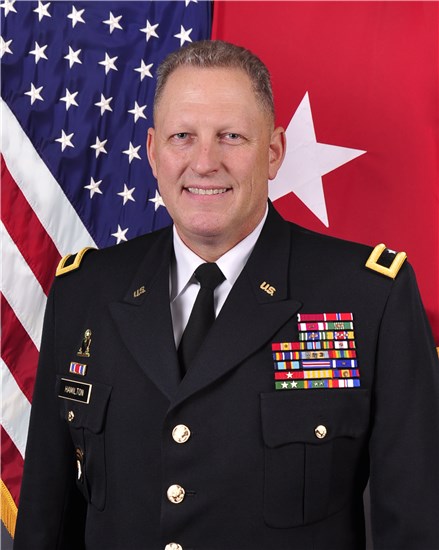 Commentary by Brig. Gen. Patrick M. Hamilton
Commentary by Brig. Gen. Patrick M. Hamilton
Commander, Domestic Operations Task Force
CAMP MABRY, Texas – Many members of the Texas Military forces are unfamiliar with the Domestic Operations Task Force also called “DOMOPS”. What is it? Who are they? What do they do? I will answer these questions and give a short history on how the Domestic Operations Task Force came to be.
Over the years leading up to the Task Force’s creation, the Texas Military Forces had responded to many hurricanes and other emergencies averaging almost 30,000 man days per year since 2001. The response effort, while effective, lacked a standing headquarters. Units who were called on to respond were always changing and Soldiers had to learn and re-learn response operations in support of civil authorities. It was quickly discovered that a permanent task force headquarters was needed.
In the fall of 2011, the Joint Staff were tasked by the Adjutant General, Maj. Gen. John F. Nichols, to devise a plan which would allow the Texas Military Forces to improve response time, maximize equipment and personnel capabilities, place various critical Domestic Operations programs on a sustainable footing, and make the best use of taxpayers’ dollars in regards to the State Active Duty (SAD) or Federal Title 32 Domestic Operations Missions. A distributed planning team was assembled and conducted a systematic planning effort to develop courses of action. After much analysis, a plan was approved. Brig. Gen. Len Smith, now Maj. Gen., spearheaded the establishment of the Domestic Operations Task Force as permanent force structure with subordinate, non-divisional units. The Domestic Operations Task Force was established on May 21st, 2012 under the command of then Brigadier General Len Smith.
The Domestic Operations Task Force is a joint organization comprised of four subordinate units and a joint staff. In addition to the joint staff, the four units that make up the task force are the Joint Task Force 136th Maneuver Enhancement Brigade (MEB), the 176th Engineer Brigade, the Joint Counter Drug Task Force, and the Southwest Border Task Force. Each of the subordinate units has a mission set that is specific to Domestic Operations, while also maintaining its federal, wartime mission.
One of these missions is the Homeland Response Force (HRF) Mission. The HRF Mission belongs to the Joint Task Force 136th (MEB) in Round Rock, Texas. The HRF mission is to provide a CBRNE (chemical, biological, radiological, nuclear, and explosive) response capability in each FEMA region that is able to provide timely life-saving skills within the first 48 hours of a CBRNE event, and to establish, when necessary, a regional command and control structure in order to synchronize all State Active Duty/Title 32 CBRNE responses involving Civil Support Teams (CST), CBRNE Enhanced Response Force Packages (CERFP) and prepare for follow-on forces. Texas is in FEMA Region VI, which is also comprised of Arkansas, Louisiana, New Mexico, and Oklahoma. The JTF 136th (MEB)’s HRF mission is evaluated and re-certified every three years.
The 176th Engineer Brigade is assigned the All Hazards mission set and provides the Joint Task Force Headquarters for Defense Support to Civil Authorities (DSCA) missions. TXMF are continuously supporting civilian authorities by responding to all hazards at the direction of the Governor, in order to preserve the lives and property of the people of Texas. Those missions include hurricane response, ground wildfire suppression, and winter storm response to name a few. The 176th’s geographic dispersion and variety of equipment make it a perfect unit for domestic all hazards response.
The Joint Counterdrug Task Force’s mission is to assist Law Enforcement Agencies (LEAs) and Community Based Organizations (CBOs) in the disruption of illicit drug financing, production, transportation and distribution, and promotes drug-free living through community-based education and prevention. The Joint Counterdrug Task Force (JCDTF) conducts operations throughout the state of Texas and along the southwest border. In addition to military counterdrug operations, the JCDTF also conducts civil operations to coach communities by delivering collaborative and effective strategies that create healthy citizens. Civil operations include the Texas ChalleNGe Academy, STARBASE, Operation Crackdown, and the Joint Substance Abuse Program.
The Southwest Border Mission (Operation Phalanx) is conducted by Joint Task Force Liberty, of which the Texas Military Forces has operational control. The Task Force’s mission is to conduct aerial detection and monitoring to disrupt Transnational Criminal Organizations (TCOs) and Drug Trafficking Organizations in support of U.S. Department of Homeland Security. JTF Liberty works closely alongside the Customs and Border Protection Office (CBP) to provide air-centric operations and increase CBP’s capability with personnel and technology. The helicopter used to conduct air operations along the border is the UH-72 Lakota and it is the premier Law Enforcement Agency support aircraft within the National Guard. The National Guard is a key partner in the Department of Defense’s efforts on border security, and our operations on the border have led to the seizure of over 75,000lbs of illegal narcotics and the apprehension of over 61,000 undocumented aliens since 2012.
As we move into hurricane and wildfire season and as activity along the southwest border is picking up, there is no question that the Domestic Operations Task Force is ready to respond at a moment’s notice. The Soldiers and Airmen of the Domestic Operations Task Force are “Texans Defending Texas.”
Brig. Gen. Patrick M. Hamilton has served over 28 years in the Texas Army National Guard and became the Commander of the Domestic Operations Task Force in June of 2013. His military career includes deployments to Bosnia and Afghanistan and has served as the Adjutant General’s Chief of Staff. Brig. Gen. Hamilton holds a bachelor’s degree from Texas A&M University and a Master of Strategic Studies from the U.S. Army War College.